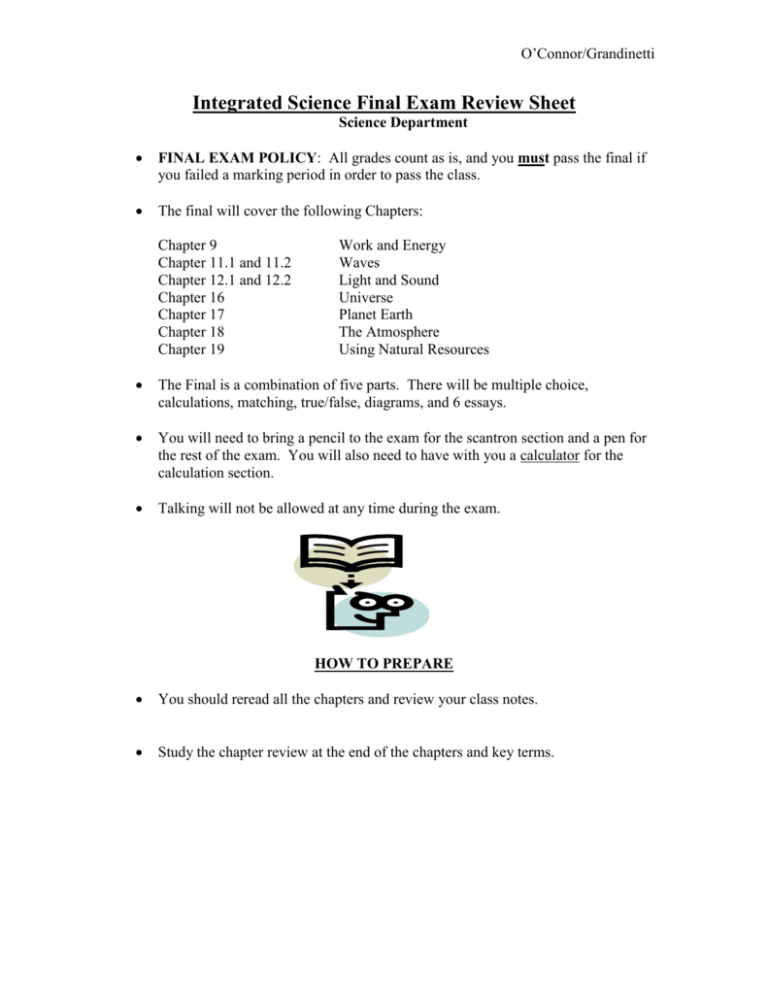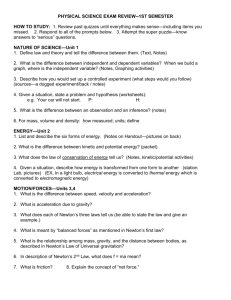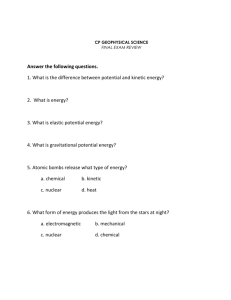two branches of science
advertisement

O’Connor/Grandinetti Integrated Science Final Exam Review Sheet Science Department FINAL EXAM POLICY: All grades count as is, and you must pass the final if you failed a marking period in order to pass the class. The final will cover the following Chapters: Chapter 9 Chapter 11.1 and 11.2 Chapter 12.1 and 12.2 Chapter 16 Chapter 17 Chapter 18 Chapter 19 Work and Energy Waves Light and Sound Universe Planet Earth The Atmosphere Using Natural Resources The Final is a combination of five parts. There will be multiple choice, calculations, matching, true/false, diagrams, and 6 essays. You will need to bring a pencil to the exam for the scantron section and a pen for the rest of the exam. You will also need to have with you a calculator for the calculation section. Talking will not be allowed at any time during the exam. HOW TO PREPARE You should reread all the chapters and review your class notes. Study the chapter review at the end of the chapters and key terms. O’Connor/Grandinetti Final Exam Key Term Review Sheet Chapter 9 Work Potential Energy Power Kinetic Energy Mechanical Advantage Review Understanding Concepts Page 315 Work, Power, Kinetic and Potential Energy Review page 315 #16-18 Chapter 11 Waves Electromagnetic Waves Crest Wavelength medium Transverse trough Period mechanical waves longitudinal amplitude wave speed frequency Doppler Effect Review Understanding Concepts Page 381 Math Review Page # 382 #18-22 Chapter 12 Parts of Electromagnetic Spectrum Frequency and energy Review Understanding Concepts Page 419 Chapter 16 Universe Planets Eclipses Galaxies and clusters Big Bang Theory HR diagrams Star Life Cycle Moon Review Understanding Concepts Page 551 Chapter 17 Layers of Earth Transforming Fault Epicenter Seismology Mineral Weathering Diverging fault Earthquakes P Waves Richter Scale Igneous Erosion Review Understanding Concepts Page 589 converging Plate Focus S Waves Volcano Types Sedimentary deposition Surface Waves Igneous O’Connor/Grandinetti Chapter 18 Layers of atmosphere Global Warming Pressure Weather tornado Seasons Ozone Problems Water Cycle Wind Cold/Warm Fronts hurricane Green House Effect Humidity Coriolis effect thunder/lightning Climate Review Understanding Concepts Page 621 Chapter 19 Ecosystem community population fossil fuels renewable resources Pollution eutrophication Review Understanding Concepts Page 657 Essay Section Topics- you pick three and I pick 3, so study them all. Work vs Power Sound wave properties and the Doppler effect The duality of light Light, radiation, and the electromagnetic spectrum Life Cycle of a stars (typical and giants) Theories of the Universe Plate tectonics Global warming and the greenhouse Ozone layer and purpose The layers of the atmosphere and weather Factors affecting ecosystems Good luck with your studies. O’Connor/Grandinetti Science Department MIXED PROBLEMS Classify the following units indicate. 1. beats/s or Hz ______________ 2. s ______________ 3. m ______________ 4. m/s ______________ 5. J ______________ 6. W ______________ Identify the equations. 1. period 2. wave speed (2) 3. frequency 4. Wavelength 5. Work 6. Power 7. Kinetic Energy 8. Potential Energy ______________ ______________ ______________ ______________ ______________ ______________ ______________ ______________ O’Connor/Grandinetti PRACTICE PROBLEMS 1. What is the power output of a 2100 N truck that travels 340 m in 560 s? 2. How much stored energy does a 54.5 kg bomb have located 1320 m above a building before it is dropped? 3. How much energy does a 9250 kg moving vehicle have if it moves with a speed of 526 m/s? 4. An air mass at 230C can hold 50 grams of water. If only 35 grams of water are held, what is the relative humidity of the air mass? 5. Ocean waves are hitting a beach at a rate of 4.0 Hz. The distance between wave crests is 18 m. Calculate the speed of the waves. 6. The speed of sound in air is about 340 m/s. What is the wavelength of a sound wave with a frequency of 120 Hz? 7. Determine the distance in meters of a star that is 7.5 light years away. The speed of light is 3.0 x108 m/s. (Hint figure out how many seconds light traveled first.)








